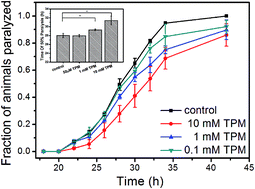A tetrapeptide from maize protects a transgenic Caenorhabditis elegans Aβ1-42 model from Aβ-induced toxicity†
Abstract
A food-derived bioactive peptide that works as an important antioxidant in vivo could be used to remedy oxidative stress-related diseases. Alzheimer's disease (AD) is influenced by the accumulation and deposition of amyloid beta (Aβ) peptides in vivo, and such accumulation may worsen under conditions of oxidative stress. This study aimed to assess whether a tetrapeptide from maize, TPM, could protect Caenorhabditis elegans against Aβ-induced disease and to clarify the possible mechanism of such protection, as well as contribute to a model of oxidative stress that influences the process of Alzheimer's disease. These parameters were tested in a C. elegans model of full-length Aβ1-42 expression (GMC101). TPM at 10 mM alleviated Aβ-induced paralysis in GMC101 under oxidative stress and normal conditions. Further studies demonstrated that TPM can efficiently inhibit Aβ aggregation in vitro and scavenge reactive oxygen species (ROS) that accelerate the accumulation and deposition of Aβ peptides in vivo. In addition, Aβ1-42 dimer and Aβ1-42 trimer were down-regulated by TPM under both oxidative stress and normal conditions. Our observations lead to the hypothesis that the bioactive peptide, TPM, is a potential drug candidate that might efficiently alleviate the symptoms of AD.


 Please wait while we load your content...
Please wait while we load your content...